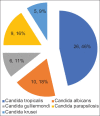Emerging threat of candida resistance among neonates at a teaching institute of Jharkhand
- PMID: 37448944
- PMCID: PMC10336938
- DOI: 10.4103/jfmpc.jfmpc_2104_22
Emerging threat of candida resistance among neonates at a teaching institute of Jharkhand
Abstract
Purpose: In the past few decades, candidemia has escalated to worrisome levels, leading to substantial morbidity and mortality in neonates. The rise in anti-fungal drug resistance demands prompt diagnosis and treatment. This study aimed to determine the speciation and susceptibility pattern of Candida species recovered from special care new-born units and identify risk factors for developing candidemia in neonates.
Method: A total of 580 blood samples from clinically suspected septicemic neonates were collected and subjected to culture. Cultures positive for yeasts were sub-cultured on Sabouraud dextrose agar. Identification of a suspected purified colony of Candida was confirmed to the species level by both conventional and automated techniques matrix-assisted laser desorption and ionization time-of-flight mass spectrometry. Anti-fungal susceptibility of isolates was performed by an automated method (VITEK 2 system) using VITEK 2 cards. Multi-variate logistic regression analysis was used to identify risk factors associated with candidemia.
Result: A total of 56 (9.66%) isolates of Candida species were recovered from 580 blood cultures. Non-albicans Candida species predominated with 82.14% of cases, whereas 17.86% of cases were caused by Candida albicans. Candida tropicalis (46.42%) was the most common isolate recovered, followed by Candida albicans (17.8%). Risk factor analyses identified a very low birth weight [odds ratio (OR) =4.05, 95% confidence interval (CI) =2.03-8.08] and prolonged antibiotic therapy (OR = 3.79, 95% CI = 1.7-8.7) among others as significant predictors of candidemia. All the Candida isolates showed 100% sensitivity to voriconazole and micafungin, whereas the overall sensitivities for fluconazole, amphotericin B, caspofungin, and flucytosine were 85.71%, 96.43%, 96.43%, and 91.07%, respectively.
Conclusion: Candidemia is a life-threatening condition in neonates. Identification of Candida species and routine anti-fungal susceptibility is a must to select a suitable and effective anti-fungal therapy to revoke emerging resistance to anti-fungals.
Keywords: Anti-fungal susceptibility tests; candida tropicalis; candidemia; very low birth weight.
Copyright: © 2023 Journal of Family Medicine and Primary Care.
Conflict of interest statement
There are no conflicts of interest.
Figures
Similar articles
-
Candida and candidaemia. Susceptibility and epidemiology.Dan Med J. 2013 Nov;60(11):B4698. Dan Med J. 2013. PMID: 24192246 Review.
-
Epidemiology of candidemia in Qatar, the Middle East: performance of MALDI-TOF MS for the identification of Candida species, species distribution, outcome, and susceptibility pattern.Infection. 2014 Apr;42(2):393-404. doi: 10.1007/s15010-013-0570-4. Epub 2013 Dec 19. Infection. 2014. PMID: 24352810
-
Epidemiology of candidemia in Shiraz, southern Iran: A prospective multicenter study (2016-2018).Med Mycol. 2021 May 4;59(5):422-430. doi: 10.1093/mmy/myaa059. Med Mycol. 2021. PMID: 32692816
-
Spectrum of candidal species isolated from neonates admitted in an Intensive Care Unit of teaching hospital of Kashmir, North India.J Lab Physicians. 2018 Jul-Sep;10(3):255-259. doi: 10.4103/JLP.JLP_1_18. J Lab Physicians. 2018. PMID: 30078958 Free PMC article.
-
Molecular characterization and antifungal susceptibility testing of Candida nivariensis from blood samples - an Iranian multicentre study and a review of the literature.J Med Microbiol. 2019 May;68(5):770-777. doi: 10.1099/jmm.0.000963. Epub 2019 Mar 29. J Med Microbiol. 2019. PMID: 30924763 Review.
Cited by
-
Can multidrug resistant Candida auris infect the neonates? Opinion on neonatal Candidemia.J Family Med Prim Care. 2023 Nov;12(11):3013-3014. doi: 10.4103/jfmpc.jfmpc_1019_23. Epub 2023 Nov 21. J Family Med Prim Care. 2023. PMID: 38186776 Free PMC article. No abstract available.
-
Addressing the silent threat: managing invasive Candida infections in hospitalized newborns.Front Pediatr. 2025 Jul 17;13:1613832. doi: 10.3389/fped.2025.1613832. eCollection 2025. Front Pediatr. 2025. PMID: 40746356 Free PMC article. Review.
-
The Development of a Clinical Registry Digital Database on Invasive Fungal Infections in India: Advancing Epidemiological Understanding and Patient Care.J Fungi (Basel). 2024 Jan 5;10(1):42. doi: 10.3390/jof10010042. J Fungi (Basel). 2024. PMID: 38248951 Free PMC article.
-
Neonatal Invasive Candidiasis: Current Concepts.Indian J Pediatr. 2025 Jul;92(7):765-773. doi: 10.1007/s12098-025-05593-9. Epub 2025 Jun 3. Indian J Pediatr. 2025. PMID: 40459650 Free PMC article. Review.
-
Research progress on the drug resistance mechanisms of Candida tropicalis and future solutions.Front Microbiol. 2025 May 12;16:1594226. doi: 10.3389/fmicb.2025.1594226. eCollection 2025. Front Microbiol. 2025. PMID: 40421464 Free PMC article. Review.
References
-
- Makhoul IR, Sujov P, Smolkin T, Lusky A, Reichman B. Epidemiological, clinical and microbiological characteristics of late-onset sepsis among very low birth weight infants in Israel:A national survey. Pediatrics. 2002;109:34–9. - PubMed
-
- Rodriguez D, Almirante B, Park BJ, Cuenca-Estrella M, Planes AM, Sanchez F, et al. Candidemia in neonatal intensive care units:Barcelona, Spain. Pediatr Infect Dis J. 2006;25:224–9. - PubMed
-
- Zaoutis TE, Argon J, Chu J, Berlin JA, Walsh TJ, Feudtner C, et al. The epidemiology and attributable outcomes of candidemia in adults and children hospitalized in the United States:A propensity analysis. Clin Infect Dis. 2005;41:1232–9. - PubMed
LinkOut - more resources
Full Text Sources
Miscellaneous



